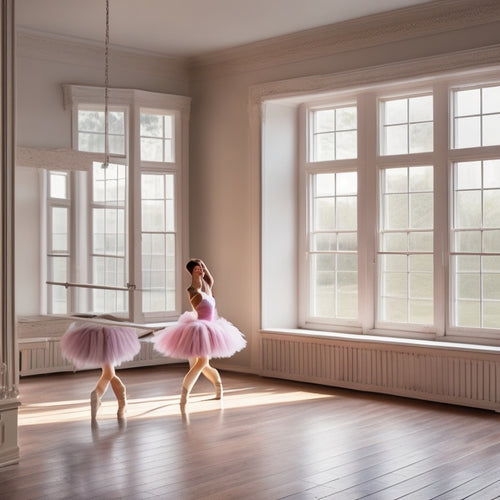
How Do I Start Ballet?
Share
You're taking the first step into the beautiful world of ballet! To get started, consider your schedule, budget, and personal goals when choosing a ballet class. Invest in quality ballet shoes and attire, and learn basic positions like First, Second, and Third Positions. Focus on foot and body alignment, and develop body awareness. Familiarize yourself with ballet terminology and vocabulary, and appreciate the rich history of ballet. As you begin, remember that proper posture, technique, and a supportive environment are key. Now, take your next step – and discover the beauty of ballet unfolding before you.
Key Takeaways
• Evaluate ballet classes based on schedule, budget, and personal goals to find the right fit.
• Invest in quality ballet shoes and attire from reputable brands to ensure proper fit and comfort.
• Master basic ballet positions, such as First, Second, and Third Positions, to establish proper alignment and technique.
• Familiarize yourself with ballet terminology and vocabulary to understand instructions and improve technique.
• Set specific, achievable goals and track progress to stay motivated and focused in your ballet journey.
Finding the Right Ballet Class
When searching for a ballet class that's right for you, consider factors like your schedule, budget, and personal goals to guarantee a fulfilling experience. You want to find a class that fits your lifestyle, so think about what works best for you.
Next, think about the Class Environment - do you prefer a small, intimate setting or a larger, more energetic class? Also, research the Teacher Qualifications - are they experienced, certified, and passionate about teaching? A good teacher can make all the difference in your ballet journey.
Choosing the Perfect Ballet Shoes
With your ballet class selected, it's time to focus on finding the perfect ballet shoes that will support your technique and help you feel confident and comfortable in class.
You'll want to explore reputable ballet brands, such as Freed of London or Grishko, that offer high-quality shoes designed for peak performance.
When trying on shoes, prioritize a proper fit by scheduling a shoe fitting at a specialty dance store or with a knowledgeable fitter. They'll help you find the perfect fit, ensuring your toes aren't cramped and your heels aren't slipping.
Essential Ballet Attire for Beginners
As you prepare for your ballet journey, you're probably wondering what to wear to class. Rest assured, we've everything you need!
Let's go over the essential attire you'll need to get started, from leotards to tights, so you can feel confident and focused on your ballet technique.
What to Wear
You'll need a few essential items to get started with ballet, and it all begins with what you wear. As a beginner, it's crucial to invest in the right attire to make sure you feel comfortable and confident.
Here are the must-haves for your ballet journey:
-
Ballet Uniforms: A classic leotard, tights, and ballet shoes form the foundation of your dance fashion.
-
Comfortable leggings or yoga pants: For a more casual, relaxed fit.
-
Dance socks or ballet slippers: To help you glide smoothly across the floor.
- Hair tie or bun: To keep your hair out of your face and off your neck.
Dress Code Essentials
Let's get specific about the dress code essentials that'll help you look and feel like a ballerina. Your ballet uniform is an essential part of your dance etiquette. Here's a breakdown of what you'll need:
| Item | Description | Tips |
|---|---|---|
| Leotard | A fitted, sleeveless top | Choose a color that complements your skin tone |
| Tights | Pink or white, convertible or footed | Make sure they're comfortable and opaque |
| Ballet Shoes | Pink or white, with a soft, flexible sole | Get them fitted at a dance store for a perfect fit |
| Skirt (optional) | A flowy, lightweight skirt | Adds a touch of elegance to your outfit |
| Hair Accessories | Bobby pins, hairnets, or a ballet bun | Keep your hair neat and out of your face |
Mastering Basic Ballet Positions
As you begin to master basic ballet positions, you'll focus on three fundamental stances: First Position, Second Position, and Third Position.
You'll learn how to correctly align your feet and body in each position, building a strong foundation for more complex movements.
With practice, you'll become comfortable and confident in these essential positions, setting yourself up for success in your ballet journey.
First Position Explained
Stand with your heels together, toes turned out to form a 'V' shape, and your weight evenly distributed between both feet, as this is the foundation of first position.
You're establishing proper alignment, which is essential for balance and movement.
As you settle into first position, focus on body awareness – feel the weight in your feet, the engagement of your core, and the length of your spine.
You're building a strong foundation for your ballet journey.
You're cultivating body awareness, essential for precise movements.
You're developing proper alignment, which prevents injuries and improves technique.
You're taking the first step towards mastering ballet, and that's something to be proud of!
Second Position Details
You take a small step to the side with one foot, keeping your heels apart, while your toes remain turned out, forming a wider 'V' shape than in first position. In second position, your weight is evenly distributed between both feet, with your knees slightly bent. This allows for proper alignment and body placement, essential for executing ballet movements correctly.
| Position | Feet | Tips |
|---|---|---|
| Second | Heels apart, toes turned out | Keep knees slightly bent |
| Weight evenly distributed | Engage core for balance | |
| Wider 'V' shape than first | Relax shoulders, keep chin up |
Remember to maintain proper posture and engage your core to maintain balance. With practice, second position will become second nature, allowing you to focus on more complex movements.
Third Position Breakdown
Building on the stability and balance you've established in second position, you'll now bring one foot to the other, with your heel aligned to the arch of the other foot, to form third position. This position requires proper alignment and muscle engagement to maintain balance and control.
Here are some key reminders to keep in mind:
- Engage your core muscles to support your posture
- Keep your shoulders relaxed and down
- Align your knees over your toes
- Visualize a straight line from head to heels to maintain balance
Understanding Ballet Terminology
Mastering the language of ballet is essential to successfully navigating the world of dance, and it starts with familiarizing yourself with its unique terminology. You'll soon realize that ballet has its own vocabulary, rooted in French and Italian.
Understanding ballet terminology will help you grasp instructions, improve your technique, and appreciate the rich Ballet History behind the art form. As you explore Dance Anatomy, you'll learn about the body's alignment, movement, and placement.
Familiarize yourself with terms like 'plié' (bend), 'tendu' (stretch), and 'arabesque' (pose). This newfound knowledge will boost your confidence, allowing you to focus on perfecting your craft.
Take your time, and don't be afraid to ask questions – you're one step closer to becoming a proficient ballet dancer.
Building Flexibility and Strength
As you begin your ballet journey, flexibility and strength training become crucial components of your daily practice, allowing you to execute movements with precision and control. It's vital to incorporate flexibility exercises and strength training into your routine to improve your overall technique.
Here are some tips to get you started:
-
Start with gentle stretches to increase your range of motion and reduce the risk of injury.
-
Incorporate strength training exercises to target your core, legs, and feet.
-
Focus on slow, controlled movements to build strength and control.
- Be patient with yourself and remember that flexibility and strength take time to develop.
Basic Ballet Exercises to Start
As you embark on your ballet journey, it's crucial to concentrate on proper posture and alignment.
You'll commence by mastering basic positions, which will serve as the cornerstone of your technique.
Through consistent practice, you'll build muscle memory and enhance your overall dancing abilities, so let's delve into these fundamental exercises and begin!
Posture and Alignment
You'll start by standing with your feet shoulder-width apart, with your weight evenly distributed between both feet, and your knees softly bent to maintain a long, straight line from head to heels. This foundation is essential for proper posture and alignment.
Engage your core by drawing your belly button towards your spine, and maintain spinal awareness by imagining a string pulling your head up towards the ceiling.
- Feel the length of your spine, from the crown of your head to your heels
- Release any tension in your shoulders and chest
- Allow your weight to distribute evenly between both feet
- Breathe deeply, feeling grounded and centered
Basic Positions Foundational
Now that you've established a strong foundation through proper posture and alignment, it's time to explore the basic positions that form the building blocks of ballet.
You'll focus on five fundamental positions: first, second, third, fourth, and fifth.
Start with your feet shoulder-width apart, toes turned out. In first position, your heels are together, toes turned out. In second position, your feet are apart, toes still turned out.
Practice shifting your weight, keeping your knees slightly bent, and engaging your core. As you move through each position, focus on body awareness, maintaining proper alignment and control.
Remember, it's not about perfection; it's about developing muscle memory and a strong foundation.
With patience and practice, you'll master these basic positions, setting yourself up for success in your ballet journey.
Finding a Ballet Community
With ballet classes and workshops scattered throughout your local community, finding a ballet community that suits your needs is just a matter of exploring your options. You'll want to find a space where you feel comfortable, supported, and motivated to improve. Here are a few things to keep in mind as you search:
-
Look for a studio with a welcoming atmosphere, where you can build relationships with your Ballet Buddies.
-
Pay attention to Studio Etiquette, such as arriving on time and respecting your fellow dancers.
-
Consider the style of ballet taught, as well as the level of experience required.
- Don't be afraid to observe a class or take a trial session to make sure it's the right fit for you.
Setting Realistic Ballet Goals
Setting realistic ballet goals helps you stay focused, motivated, and committed to your progress, allowing you to celebrate small victories along the way. By setting specific, achievable goals, you'll cultivate a growth mindset and develop a healthy ballet mindset. Track your progress with a goal-tracking system, and break down large goals into smaller, manageable tasks. This will help you stay on track and make steady progress.
| Goal | Timeline | Progress |
|---|---|---|
| Master a single pirouette | 1 month | 75% |
| Perform a full ballet routine | 3 months | 25% |
| Attend a professional ballet performance | 2 months | 50% |
| Practice ballet 3 times a week | Ongoing | 90% |
Overcoming Common Beginner Fears
Fears of embarrassment, injury, or not being flexible enough often hold beginners back from fully embracing ballet. However, you can overcome these common anxieties by recognizing they're normal and temporary obstacles.
As you prepare to start ballet, remember that:
-
Fear of judgment is natural, but focusing on your growth, not others' opinions, is crucial.
-
Fear of failure is an opportunity to learn and improve – every mistake is a step forward.
-
Self-doubt strategies like positive affirmations and visualization can boost your confidence.
- Mental preparation tips, such as setting realistic goals and practicing mindfulness, will help you stay focused and motivated.
Frequently Asked Questions
Can I Learn Ballet if I'm Not Flexible?
"You can absolutely learn ballet, flexibility notwithstanding! Focus on building body awareness, and make a mindset shift: it's not about being flexible, but about listening to your body and honoring its unique capabilities."
Do I Need to Have a Dance Background to Start Ballet?
You don't need prior dance experience to start ballet; natural ability isn't required either. What matters most is your willingness to learn and have fun - you can develop your skills and style with practice and patience.
Can I Practice Ballet at Home Without a Teacher?
You can definitely practice ballet at home without a teacher, setting up a mini Home Studio with mirrors and a barre, and utilizing online resources like video tutorials and classes to guide you.
How Long Does It Take to See Progress in Ballet?
You'll start seeing progress in ballet with consistent practice, even if it's just 15-20 minutes daily. Track your milestones, like mastering a new step or improving posture, and celebrate small wins to stay motivated.
Is It Too Late to Start Ballet if I'm Over 30?
"As you blossom into your Midlife Renaissance, remember, it's never too late to start ballet. You, an Adult Beginner, can still unfold like a rose, petals of potential unfurling with each delicate step, and every plié a celebration of your inner beauty."
Related Posts
-

Why Lyrical Dancers Need Pro Makeup Guidance Online
As a lyrical dancer, you know that a polished, performance-ready look is essential to showcasing your skills and conv...
-

Most Comfortable Ballet Tutus for Dancers
When searching for the most comfortable ballet tutus, prioritize breathable fabrics like chiffon and cotton blends. T...
-

Benefits of Wearing Activity Trackers Daily
Wearing an activity tracker daily can transform your fitness routine. You'll gain understanding into your daily steps...


